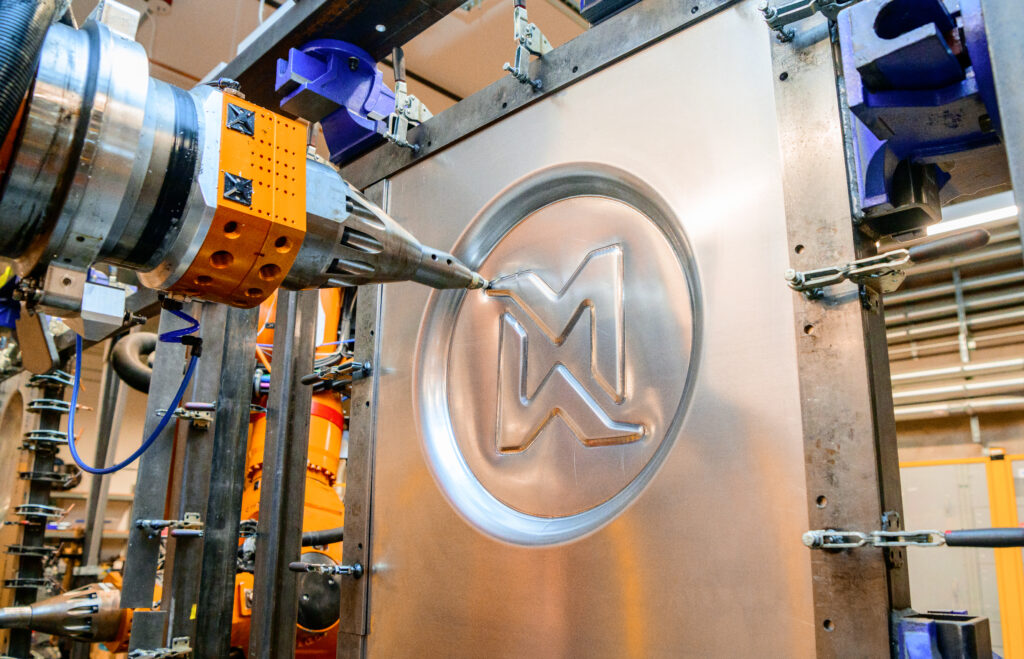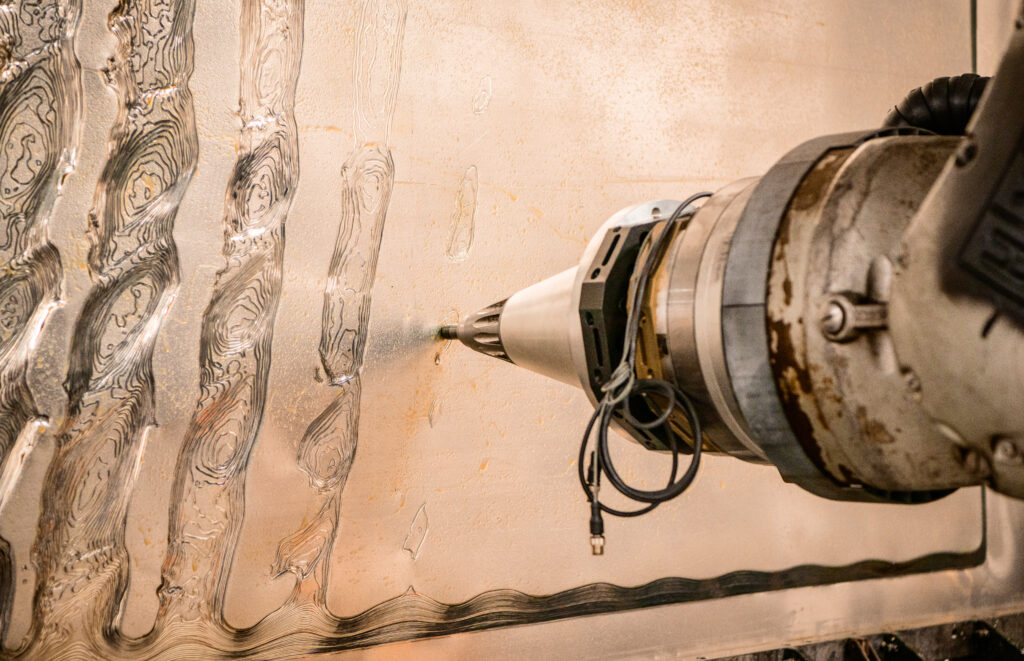Los Angeles-based startup Machina Labs has introduced its new Machina Deployable System, a flexible manufacturing setup that customers can purchase and implement on their own sites. Specializing in roboforming technology, Machina Labs has developed a robotic arm system capable of scanning, trimming, and bending metal sheets into various structures. The startup already has customers employing their system for both sustainment purposes and the production of large sheet metal components. Notably among these is the United States Air Force, known for its adventurous exploration of additive technologies.
Through the integration of sensors, 7-axis robots, and what could be called the ‘magic’ of artificial intelligence, the company aims to offer a readily configurable production cell for a wide range of objects. The system is versatile, compatible with materials such as Inconel, aluminum, and steels, and capable of producing parts measuring up to 3.6m by 1.5m by 1.2m. Machina Labs anticipates that the production unit will require minimal infrastructure and can be quickly installed by clients.
“Machina Labs has a mission to develop manufacturing solutions that give businesses the ability to make changes with ease, and iterate and produce rapidly. Our portable Deployable System is a game-changer in the manufacturing world. By providing manufacturers with a portable solution that combines flexibility, precision, and speed, we are essentially putting a twenty-first century blacksmith shop in the backyard of any business that wants one,” said Machina Labs CEO Edward Mehr.
Equipped with two Kuka 7-axis robot arms and a tool changer, the system may not be inexpensive, but it is designed to fit conveniently on a truck. Machina Labs is demonstrating the system’s capabilities at the FABTECH event taking place this week in Chicago. While there may be debate over whether Machina Labs’ technology qualifies as an additive process, it certainly serves as both a complement and a competitor to directed energy deposition (DED) and wire arc additive manufacturing (WAAM) applications. Moreover, Machina rival Figur was acquired by 3D printing firm Desktop Metal, demonstrating the overlap of sheet metal forming. Traditional additive methods often struggle with sheet-like structures, yet sheet material is ubiquitous and relatively inexpensive. As such, this innovation from Machina Labs is one to keep an eye on.
 Comcast technicians explain how to activate emergency generators on Friday, July 16, 2021 in Manteca, Calif. (Josh Edelson/AP Images for Comcast)
Comcast technicians explain how to activate emergency generators on Friday, July 16, 2021 in Manteca, Calif. (Josh Edelson/AP Images for Comcast)The Machina Market?
Machina Labs burst onto the scene in 2021, backed by a reported $16 million in funding, and its vision is undeniably captivating. The prospect of an easily reconfigurable system for producing large, inexpensive metal components on-site is alluring. However, questions remain about its competitive advantages. How does it stack up against an automated system that combines water jet or laser cutting with welding? Which specific parts and scenarios would it excel in over such a setup?
Furthermore, what is the actual customer demand for this kind of system, considering the gap between the part costs and the overall investment required? The fact that Ford, GM, Toyota, Nissan, and Boeing have researched similar techniques suggests that there is a niche here. In fact, Ford began showing off a technique it called Ford Freeform Fabrication Technology circa 2013.
While the technology is flashy and filled with promise, experience shows that achieving a good product-market fit is often more critical than having a groundbreaking technology. I’m hopeful that Machina Labs will find its niche, but it’s clear that the path to success involves more than just technological prowess.
Do Industrial Robot Arms Dream of Cars?
Kuka, one of the leading robot arm manufacturers in the world, has thrown its support behind Machina Labs, which is no small endorsement. This backing comes at a time when competition among robot arm providers is intensifying, fueled not just by established players like Yaskawa, ABB, Fanuc, Kawasaki, and Denso, but also by emerging low-cost Chinese brands. To maintain a competitive edge, companies are actively seeking ways to fortify their market positions. Denso, for example, employs a strategy of using its own robotic arms to enhance the efficiency of car part manufacturing. For the rest of the field, building a defense against competition will likely involve targeting high-end markets, driving innovation, or identifying novel applications for their technology.
Stellar Growth, Innovation or Applications
The high-end sectors like new space and satellites are experiencing tremendous growth. Some companies in the satellite market are reporting growth rates in the thousands of percent, while certain new space engine suppliers have backlogs amounting to hundreds of millions of dollars. However, entering this market could be challenging due to regulatory hurdles and the often unpredictable behavior of firms in these sectors. While innovation is always a possibility, I can’t offer specific insights into the future of robotics technology.
When it comes to potential applications, sectors like 3D-printed construction, large-scale polymer 3D printing, and DED/WAAM technologies seem to be natural fits for robotic companies. Enterprises like Machina Labs, AI Build, or MX3D would be attractive acquisitions for major robotics firms, as would companies like CyBe, which uses robot arms for concrete work, or Caracol, which employs robot arms to print polymer components. KUKA, for instance, has been proactively engaging with various application-specific companies, collaborating on production cells with AI Build, partnering for concrete 3D printing with Besix, and now supporting Machina Labs. This appears to be a sound strategy. The complacency displayed by other major robot arm companies in not seizing opportunities in emerging industries seems to be a missed chance for significant engagement.
One of the most promising sectors for the integration of 3D printing with robot arms lies in austere production environments, naval sustainment, and defense manufacturing. In these contexts—whether it’s boats, drones, airframes, chassis components, missiles, or tank hulls—robotic arms stand to become the future of production tooling, both in domestic factories and on the front lines. However, there’s a nuanced issue when considering the involvement of Machina Labs and Kuka in such sensitive applications.
Kuka is a Germany-based company and a subsidiary of Midea, a large Chinese conglomerate known for manufacturing household appliances like air conditioners, microwaves, and refrigerators. Despite having a past marked by some serious quality issues, Midea boasts significant financial power, boasting revenue figures comparable to companies like Nike, American Airlines, and Morgan Stanley. Midea’s acquisition of Kuka, a global leader in industrial robots, is undeniably a shrewd move.
That said, the relationship raises security concerns when considering military applications. While assurances may be made about ring-fencing and data protection, the fact remains that Chinese companies are obliged to support their state. The temptation to access sensitive data—such as tool paths, locations, and operational hours—could pose a considerable risk if these robots were used for U.S. naval sustainment or army base construction. Therefore, despite the potential advantages, the association with Kuka, given its parent company, could be a significant limiting factor for the wider adoption of this technology in sensitive areas, regardless of any promises made.
Subscribe to Our Email Newsletter
Stay up-to-date on all the latest news from the 3D printing industry and receive information and offers from third party vendors.
Print Services
Upload your 3D Models and get them printed quickly and efficiently.
You May Also Like
Heating Up: 3D Systems’ Scott Green Discusses 3D Printing’s Potential in the Data Center Industry
The relentless rise of NVIDIA, the steadily increasing pledges of major private and public investments in national infrastructure projects around the world, and the general cultural obsession with AI have...
3DPOD 260: John Hart on VulcanForms, MIT, Desktop Metal and More
John Hart is a Professor at MIT; he´s also the director of the Laboratory for Manufacturing and Productivity as well as the director of the Center for Advanced Production Technologies....
Etsy Design Rule Change Reduces Selection of 3D Printed Goods
Online marketplace Etsy has implemented a rule change requiring all 3D printed goods on the site to be original designs. The update to the site’s Creativity Standards states, ¨Items produced using...
E-Beam OEM Wayland Additive Partners with USC Racing to 3D Print Titanium Exhaust Collector
Every year, standards organization SAE International holds a competition called Formula SAE, in which students from both undergraduate and graduate programs design, build, and race small formula-style race cars. For...



































